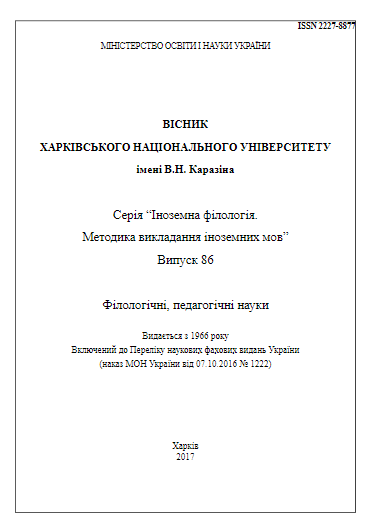Quasi-realia as a means of objectifying fantastic worldview and the specifics of their translation (a case study of the children’s novel “Charlie and the Chocolate Factory” by R. Dahl)
Abstract
A literary work is a reflection of the author’s worldview, objectified in a text with the help of linguistic and figurative means, which are always chosen according to the author’s intentions and aimed at rendering a particular image or thought. Markers of the author’s worldview usually comprise the elements which are the most efficient to reproduce the author’s understanding of the reality and pragmatics of his works. The system of the author’s linguistic means gives a vivid characteristic of his individual style and the peculiar worldview, making it possible to interpret the markers of the writer’s linguistic personality and the principles of shaping his artistic creed. Fantastic worldview as a form of quasi-reality representation in a fictional geographical space has numerous features, distinguishing it from real life. One of the features characterizing R. Dahl’s individual style is the use of quasi-realia, aimed at making the fantastic worldview convincing and producing the necessary aesthetic impact on a reader. Rendering grammatical and semantic integrity of the author’s linguistic innovations efficiently makes the translator advert to the macrocontext, use various translation techniques and study profoundly the author’s individual style, compelling them to face the problem of choosing the most appropriate translation equivalents. The contrastive analysis of quasi-realia translation into Ukrainian and German will make it possible to investigate the adequacy of rendering R. Dahl’s individual style as well as the peculiarities of the fantastic worldview presented in his children’s works.
Downloads
References
Кашкин В.Б. Сопоставительная лингвистика / В.Б. Кашкин. – Воронеж : Воронежский государственный университет, 2007. – 88 с.
Кубрякова Е.С. Языковое сознание и языковая картина мира / Е.С. Кубрякова // Филология и культура: тезисы межд. конф. – Тамбов : ТГУ им. Г.Р. Державина, 1999. – С. 6-13.
Морева Т.Ю. Фантастические повести В.Ф. Одоевского и О. Стороженко (мифомышление как проявление национального сознания) [Электронный ресурс] / Т.Ю. Морева. – Режим доступа : http://dspace.onu.edu.ua:8080/bitstream/123456789/ 8592/1/320-331.pdf.
Неелов Е.М. Фантастический мир как категория исторической поэтики [Электронный ресурс] / Е.М. Неелов. – Режим доступа : http://philolog.petrsu.ru/filolog/konf/ 1990/04neyolov.htm.
Ребрій О.В. Сучасні концепції творчості у перекладі : [монографія] / О.В. Ребрій. – Х. : ХНУ імені В.Н. Каразіна, 2012. – 376 с.
Тіліга А.Ю. Відтворення топоніміки як складової фантастичної художньої картини світу в англо-українських перекладах [Електронний ресурс] / А.Ю. Тіліга. – Режим доступа : http://essuir.sumdu.edu.ua/ bitstream/123456789/ 25316/1/Tiliga.pdf.
Чуковский К.И. Высокое искусство / И.К. Чуковский. – М. : Советский писатель, 1968. – 384 с.
Щирова И.А. Многомерность текста: понимание и интерпретация / И.А. Щирова. – СПб. : ООО «Книжный Дом», 2007. – 472 с. 10. English Oxford living Dictionaries [Electronic resource]. – Access : https://en.oxforddictionaries.com/definition.




